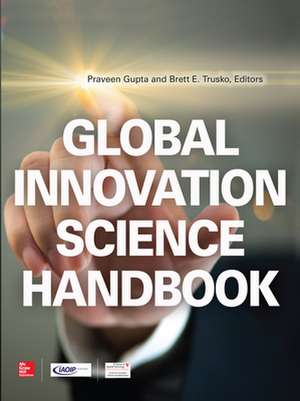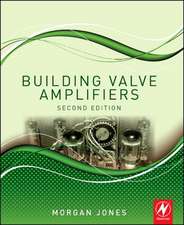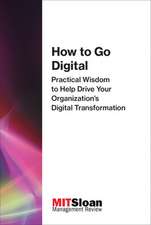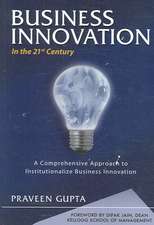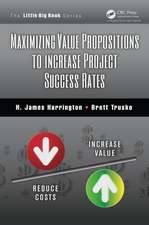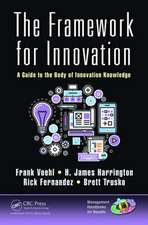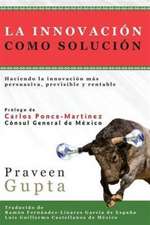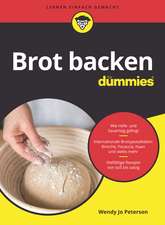Global Innovation Science Handbook
Autor Praveen Gupta, Brett Truskoen Limba Engleză Hardback – 16 feb 2014
Publisher's Note: Products purchased from Third Party sellers are not guaranteed by the publisher for quality, authenticity, or access to any online entitlements included with the product.
A GROUNDBREAKING GUIDE TO THE ART, SCIENCE, TOOLS, AND DEPLOYMENT OF INNOVATION
"It has never been more important to educate people and organizations how to out-imagine, out-create, and out-innovate....The insight and experiences captured by [this book] make an important contribution toward reaching this goal." -- From the Foreword by Deborah Wince-Smith, President, Council on CompetitivenessDeveloped by the editors of the International Journal of Innovation Science and featuring contributions from more than 40 innovation experts and thought leaders, Global Innovation Science Handbook presents a proven approach for understanding and implementing innovation in any industry.
This pioneering work is based on a defined body of knowledge that includes intent, methodology, tools, and measurements. It challenges the popular paradigm that "learned" innovation is impossible, and lays out a systematic process for developing innovation skills. Each chapter can be independently read and utilized in the daily practice of innovation. Real-world case studies from financial, government, and education sectors illustrate the concepts discussed in this definitive resource.
Global Innovation Science Handbook covers:
- Preparing for innovation--establishing a framework and creating a culture for innovation
- Key innovation concepts, such as creativity, neuroscience, biomimetics, benchmarking, and ethnography
- Creativity tools, including Kano analysis, storyboarding, absence thinking, Lotus Blossom, SCAMPER, and others
- Techniques essential to innovation science, such as Six Thinking Hats, mind mapping, social networks, market research, and lead user analysis
- Innovation radar, indices, and other measurements
- Idea management--the process of creating, screening, exploring, and evaluating ideas to bring those most valuable from concept to reality
- Innovation methodologies, including TRIZ, Brinnovation, crowdsourcing, Eureka, stage gate, and others
- Deployment--a life-cycle approach involving inspiration, strategy, organization, excellence, culture, measurement, protection of intellectual property, and launch
- Case studies featuring cutting-edge technological innovations in finance, government, and education
Preț: 609.19 lei
Preț vechi: 866.80 lei
-30% Nou
Puncte Express: 914
Preț estimativ în valută:
116.57€ • 121.71$ • 96.47£
116.57€ • 121.71$ • 96.47£
Carte tipărită la comandă
Livrare economică 04-09 aprilie
Preluare comenzi: 021 569.72.76
Specificații
ISBN-13: 9780071792707
ISBN-10: 0071792708
Pagini: 896
Dimensiuni: 224 x 285 x 31 mm
Greutate: 1.81 kg
Editura: McGraw Hill Education
Colecția McGraw-Hill
Locul publicării:United States
ISBN-10: 0071792708
Pagini: 896
Dimensiuni: 224 x 285 x 31 mm
Greutate: 1.81 kg
Editura: McGraw Hill Education
Colecția McGraw-Hill
Locul publicării:United States
Cuprins
Introduction
Section 1: Preparing for Innovation
Chapter 1: Strategy for Innovation
Basic Tenets of Business Success
Strategy Execution
Developing the Innovation Strategy
Reducing Risks of Investment in Innovation
Marketing Innovations
Launching the Innovation Initiative
Resources for Innovation
Organization Structure
Communicating the Innovation Message
Incentives and Controls
Culture and Change
Identifying Gaps
Innovative Leadership
Making an Innovation Strategy Work
Leading Innovation with a Sense of Urgency
References
Chapter 2: Creating Your Innovation Blueprint: Assessing Current Capabilities and Building a Roadmap to the Future
Two Key Innovation Challenges
Turning Chaos into Shared Strategy—Seeing the Future
Strategy into Action—Aligning the Key Drivers of Innovation
Benefits of an Innovation Blueprint
Key Elements of an Innovation Blueprint
Business
Organization
STEP
Alignment
Adding Current and Future to the Blueprint
Three Drivers of Innovation
Using the Blueprint to Build the Innovation Capability of Your Enterprise
Planning for the Future and Assessing Current Capabilities
Innovation Blueprint: External Environment
External Environment—The True “Front End of Innovation”
Staying Connected to Your Customers
The External Environment Indicates the Kind of Innovation Needed
Adding Industry Lifecycle to Your Blueprint
Lifecycle Curves
Lifecycle Curve Implications for Your Blueprint
Assessing Current Capabilities—External Environment
Innovation Blueprint: Task
Task: Big Picture Strategy
Innovation Strategy—Getting the Big Picture Right
Creating a Balanced Portfolio of Innovations
Innovation Strategy: Bottom-Up and Top-Down, Inside-Out and Outside-In
Task: Creating an Integrated System for Turning Insight into Innovations
Explore Opportunities
Generate Breakthrough Ideas
Optimize Value
Selecting and Funding the Best
Mobilizing for Results/Commercialization
Assessing Current Capabilities—Task
S—Structure
Innovation Architecture
Organization Alignment for Innovation
Assessing Current Capabilities—Structure
P—People
Informed Innovators
Capable Innovators
Innovators Everywhere
Talents and Skills for the Future
Innovation Champions
Collaborative Teams
Assessing Current Capabilities—People
Ei—Internal Environment
Assessing Current Capabilities—Internal Environment
Three Drivers: Leadership, Stakeholder Engagement, and Innovation Support
Leadership
Assessing Current Capabilities—Leadership for Innovation
Stakeholder Engagement
Assessing Current Capabilities—Stakeholder Engagement
Innovation Support
Assessing Current Capabilities—Innovation Support
Conclusion
References
Chapter 3: The Culture for Innovation
What Is Culture?
Why Is Culture Important?
Does Your Organization Care about Its Culture?
How Do We Know and How Is It Measured?
Social Style
Problem-Solving Style
Understanding the Impact of Culture
How Does One Go About Changing Culture?
Summary
Bibliography
Chapter 4: Leading Innovation: Ten Essential Roles for Harnessing the Creative Talent of Your Enterprise
Introduction
Playing the 10 Roles
1. Futurist
2. Direction Setter
3. Customer Advocate
4. Architect
5. Venture Capitalist
6. Mentor
7. Barrier Buster
8. Networker
9. Culture Creator
10. Role Model
Conclusion
References
Section 2: General Concepts
Chapter 5: Creating Creativity: Personal Creativity for Personal Productivity
Introduction
What Is Personal Creativity?
How Does Personal Creativity Work?
Diverse Inputs/Inclusive Thinking
Context Articulation
Divergent Thinking and Convergent Thinking
Common Barriers to Effective Personal Creativity
Effective Strategies to Power Up Personal Creativity
References
Chapter 6: The Creative Corporation
Introduction
Defining Corporate Creativity
“Best Practices” in Corporate Creativity
Abstract Rules and Corporate Creativity
Effectuation and Corporate Creativity
The Bird in the Hand Principle
The Affordable Loss Principle
The Lemonade Principle
The Crazy Quilt Principle
The Pilot in the Plane Principle
Conclusion and Action Items
References
Chapter 7: Innovation Neuroscience Hardware
Overview of Brain Anatomy
The Innovation Process in the Brain
Accelerating the Innovation Process in the Brain
Summary
References
Chapter 8: Innovation and Neuroscience
Introduction
Chapter Overview
Current Applications of Neuroscience
Neuromarketing and Neuroeconomics
Neuroesthetics
Potential Applications of Neuroscience to Innovation
The Genesis of New Ideas
Knowing When You’ve Got the Right Idea
Barriers to Innovative Thinking
We’ve Always Done It That Way
Applying Neuroscience Insights to Innovation
Innovation Process
Talent Selection for Innovation
Developing Innovation Skills
Cultivating an Innovation Mind-Set
Creating an Environment for a Successful Innovation Program
Conclusion
References
Chapter 9: Biomimetics: Learning from Life
3.8 Billion Years in the Making: An Introduction to Biomimetics
We Have the Technology: Bionics for the Body
We All Have the Technology: DIY Bionics for All
A City for All Seasons: Biomimetics in the Built Environment
Our Ever-Evolving Future: Possible Biomimetic Futures
Bibliography
Chapter 10: Innovation Benchmarking
Introduction
Definitions
Forms of Benchmarking
Finding the Variables
Finding the Metrics and Choosing the Weight
The Process of Benchmarking
Finding the Data (or Benchmarking Intelligence)
National Innovation Systems
Benchmarking Challenges
Conclusion
References
Chapter 11: Process, Practice, and Innovation
Introduction
Distinction without a Difference
Process and Practice—Different Characteristics
Lean versus Innovative
Predictable versus Unpredictable
Input, Routine Driven versus Goal Seeking
Precise versus Fuzzy
Codeable/Calculable versus Arguable/Negotiable
Efficiency versus Effectiveness
Frictionless versus Friction
Optimize versus Satisfice
Autopilot versus Sense-Making
Training-Based versus Education-Based
Processes Derive from Practices
Mismatched Situations and Activities
Rote Practices
Bureaucratic Processes
Process and Practice—Different Information Requirements
Minimal Data versus Maximum Information
Summary
References
Chapter 12: Ethnography
Introduction
Need for Ethnography
Ethnography and Innovation
Ethnography Skills and Tools
Speeding Ethnographic Research
Institutionalizing Ethnographic Research
Summary
References
Section 3: Creativity Tools
Chapter 13: Creativity Tools: Develop Creative Solutions to Problems and Opportunities
Step 1: Finding Opportunities and Problems to Solve (Preparation)
Tool 1: The Quickscore Creativity Test
Tool 2: Kano Analysis
Tool 3: Nominal Group Technique
Tool 4: Synectics
Tool 5: Brainstorming or Operational Creativity
Tool 6: Six Thinking Hats
Step 2: Gathering and Reflecting on Information (Incubation)
Tool 7: Attribute Listing, Morphological Analysis, and Matrix Analysis
Tool 8: Generating New Ideas with Storyboarding
Tool 9: Absence Thinking
Step 3: Opportunity Exploration (Insight)
Tool 10: Breakdown (Drilldown) Tree Diagram
Tool 11: Lotus Blossom
Step 4: Generating and Evaluating Ideas (Evaluation)
Tool 12: TRIZ Analysis
Tool 13: SCAMPER
Step 5: Implementation (Elaboration)
Tool 14: Mind Mapping
Tool 15: Affinity Diagram
Tool 16: Force Field Analysis Diagram
Summary
References
Chapter 14: Creativity Education: A Catalyst for Organizational Prosperity
Context: The Evolution of Creativity as a Business Imperative
Edward De Bono’s Impact
The Six Thinking Hats®
The Six Thinking Hats Tool
Lateral Thinking
Daniel Pink’s Impact
The Conceptual Age of the 21st Century
The Case for Creativity or Why Right-Brainers Will Rule the World
The Six Senses
The Compelling Case for Creativity at Work
Reinvigorating Our Long History of Creativity and Innovation
What Does Creativity in Action Look Like?
General Motors Rises from the Ashes with an Identity Change
The Fundamentals: Preparing Our Children for Success in the Conceptual Age
Keeping Creativity Alive in Education
Reawakening Creativity in the Workplace
We Are All Creative
Bridging the Gap between Creativity and Commerce
The New Leadership—Blending Creativity with Business Acumen
Ringling College Example: Preparing Tomorrow’s Business Leaders—A Design, Art, and Business (Whole Brain) Approach
The Ringling College Creativity Center (RC3)—Sharing What We’ve Learned about Teaching Creativity
Creativity Immersion—An Alchemical Process for Changing Hearts and Minds around Work
Overview: The Whole Brain Approach to Learning
Learning Outcomes
Retreat Overview
An Orchestrated Experience
The Guided Artistic Journey
From Art to Business—Translating the Immersive Experience
Cutting-Edge Creativity-Related Content
Business-to-Business Learning
Through the Eyes of Artists—A Running Documentary of the Retreat Process
Embedding Creativity: The Post-Retreat Process
Example: A Manufacturing Firm Redefines Itself
What Does a Creative Leader Look Like?
Creative (Whole Brain) Leaders Are Organizational and People-Focused
The Creative Individuals’ and Leaders’ Toolkit of Qualities, Attitudes, and Behaviors
The Ongoing Journey
References
Chapter 15: Unlocking Your Creativity Using Mind Mapping
What Is Mind Mapping?
Why Mind Mapping Promotes Creativity
Working with the Brain
Getting Started with Mind Mapping
The Main Word or Phrase
First Level Ideas
Second Level Ideas
Additional Levels
Proven Creative Uses for Mind Mapping
Studying
Presentations
Taking Notes
Brainstorming
Decision Making
Overcoming Writer’s Block
Unlocking Creativity with Mind Maps
Beyond the Brainstorming—Benefits of Mind Mapping Throughout a Project
First Revision of the Mind Map
Organizing Logically
Assigning Responsibility
Scheduling
Tracking Tasks
Project Completion and Error Checking
Making Mind Mapping a Part of Everyday Life
Tips for Mind Mapping
References
Chapter 16: Social Networks
How Social Technologies Transform Innovation
The Social Enchilada
Economics and Markets
Examples of Social Network–Powered Innovation
3M: Creating a Global Research Lab Campus with a Social Network
P&G: Using Social Networks to Scale Product Innovation
State Farm: Engaging Generation Y/Z with Digital/Physical Social Network
Fenland, Cambridgeshire: Social Network Integrates Fractured Community
Social Network Innovation Models
Getting Started: Using Social Networks for Innovation
Focus on People
Use an Agile Approach
Lead with Sociality
Conclusion
References
Chapter 17: Innovation Combination Methods
Problem Solving versus Innovation
More Detail on Defining Contradictions
Combining Methods
The Problem-Solving Path
Problem-Solving Methodologies
Plan-Do-Study-Act
Six Sigma
Lean (a.k.a. Toyota Production System)
Root Cause Analysis
Functional Analysis
Systems Engineering
Contradiction Analysis
Technically Focused Brainstorming
Methodology Merger
Case Studies
Operating Room Utilization Improvement—Six Sigma Case Study
Wireless Power System Improvement—System Innovation Case Study
Conclusion
References
Chapter 18: Market Research in the Process of New Product Development
Introduction
Market Research
Definition of Market Research
Market Research in Innovation Management
Importance of Market Research for Successful Innovations
Market Research Process
Use of Market Research Methods in the Innovation Process
Systematization of the Market Research Methods
Summary
List of Abbreviations
References
Chapter 19: Lead User Analysis
User Involvement: Ford or von Hippel?
Lead Users
Who Are Lead Users?
Are Lead Users a Distinct “Species”?
What Do Lead Users Do?
The Lead User Method
Phase 1: Getting Started
Phase 2: Identification of Major Needs and Trends
Phase 3: Identification of Lead Users
Phase 4: The Lead User Workshop
Variants of and Alternatives to the Lead User Method
Crowdsourcing
Toolkits for User Innovation and Design
References
Section 4: Idea Management
Chapter 20: Managing Development of Innovation Ideas
What Factors Limit the Acquisition and Development of Viable Innovation Ideas?
Innovation Activity Disrupts at All Levels: From Employees to Market
Thrashing or Formal Reliable Creative Process
Innovation Process Must Be Creative and Reliable
Afraid of Failure?
Fast-Track Innovation Development Pathways
Seeking Innovation Ideas
Areas of Potential Opportunity
Perspectives
Decisions
How Do We Form Innovative Ideas?
Does Everyone Innovate?
Conclusion
References
Chapter 21: Quality of Ideas
Introduction
The Concept of Ideas
Conventional Suggestion Systems
Need for Ideas
Sources of Ideas
An Environment for Engagement
Experience and Energy Levels
Methods for Generating Ideas
Brainstorming
Thinking Innovatively
Online Collaboration
Evaluating Ideas
Emotional Evaluation
Value of an Idea
Prioritization
Excellence in Idea Management
Summary
References
Chapter 22: Idea Evaluation and Management
Introduction
Overview of Idea Evaluation and Management
First and Final Screen
Common Problems
Gathering Evidence
Analysis
Summary
References
Section 5: Methodologies
Chapter 23: Types of Innovation
Introduction
Symptoms
Process Innovation
Functional Innovation
Design Innovation
Product Innovation
Service Innovation
Business Model Innovation
Co-creation Innovation
Open Innovation
“Not Invented Here” versus “The Wheel Not Reinvented”
Conclusion
References
Chapter 24: TRIZ: Theory of Solving Inventive Problems
Problem Solving with TRIZ
TRIZ Tools for Problem Analysis
Function Analysis and Trimming
Zones of Conflict and Resources
System Operator, or the 9 Windows
Solving Problems by Eliminating Contradictions
Solving Problems Using the 76 Standard Solutions
Solving Problems Using “Effects” from Other Technologies
Trends of Evolution
Strategic Use of the Patterns of Evolution
Research and Changes in TRIZ
Bibliography
Appendix 1. The 40 Principles for Inventive Problem Solving
Chapter 25: Brinnovation (Breakthrough Innovation)
Evolution of Innovation
Great Innovators
Knowledge Innovation
Institutionalizing Innovation
A New Framework for Innovation
An Innovation Model
Innovation Categories
The Breakthrough Innovation Process
The TEDOC Methodology
Innovative Idea Generation
Encouraging Innovation in an Organization
Defining Innovation
Summary
Bibliography
Chapter 26: Crowdsourcing: Tapping into the Talent of the Crowd
Introduction
The Renaissance of Amateurism
The Open Source Software Movement
Availability of New Tools of Production
Self-Organized Communities
The Crowdsourcing Definition
Characterization of Crowdsourcing Activities
Steps to Organize a Crowdsourcing Process
Examples, Uses, and Applications of Crowdsourcing
Creation of Content
Distributed Work
Collective Intelligence and Distributed Knowledge
Crowdfunding
Open Innovation
Conclusion
References
Chapter 27: Open Innovation
Introduction
Networks and Innovation
Open Innovation: When a Firm’s Borders Perish
From Traditional Innovation to Open Innovation
SMEs and Open Innovation
Open Innovation among SMEs in Emerging Countries
Innovation Programs in Turkey
Evidence from the Aegean Region
Results
Conclusion
References
Chapter 28: Systematic Innovation
Introduction
Brief History of Systematic Innovation
Why We Need Systematic Innovation
Summary
Anatomy of Systematic Innovation for Product Development
Conclusion
References
Chapter 29: Eureka! What Insight Is and How to Achieve It
Introduction
Myths about Insight
Dostoyevsky and the Complete and Whole Myth
Newton, Darwin, and the Single Trigger Myth
Technique #1: Emulating the Insightful
The Process of Insight
The Role of Experience in Insight
The Role of Recall and Adaptation
The Role of Curiosity, Questions, and Goals
Darwin’s Competitor: Parallels and Differences
Insight Defined
Technique #2: Making the Creative Connection
How to Get More Insights
Technique #3: Using Questions to Find Insightful Answers
Technique #4: Indexing Ideas for Better Reminding
Technique #5: Adapting Partial Matches
Substitution in Partial Matches
Non-Obvious Matches
Insights in Action: Some Final Examples
Sydney Opera House
Felice Frankel’s Photographs
Dostoyevsky Revisited: Crime and Punishment
Putting It All Together: Hunt’s Insight and Beyond
Exercise: Mulling over Hulls
Conclusion
Chapter 30: Stage-Gate
The Phased Review Process
Objectives of a Phased Review Process
Overview of the Phased Review Process
The Phases in Detail
Phase 1: Opportunity Identification
Phase 2: Idea Generation
Phase 3: Concept Evaluation
Phase 4: Development
Phase 5: Launch
Evaluative Tasks in the Phased Review Process
Radical Products and the Phased Review Process
Third-Generation Processes
Best Practices in Phased Review Processes
References
Chapter 31: Design Innovation
Why Design Innovation Matters: The Innovation Gap
The Balanced Breakthrough Model
The Four-Square Model for Design Innovation
Reframe the Problem
Work at the Right Level of Abstraction
Focus on Activities Not Problems (or Technology)
Activity Models: The 5E’s Framework
Activity Models: Customer Journey
Activity Models: Three Levels of Why
User Models: The Empathy Map
User Name
What Are They Thinking?
What Are They Feeling?
What Are They Saying?
What Are People Doing?
What Won’t They Tell You?
“How Might We” Statements
Prototyping
References
Chapter 32: Service Innovation: Introduction, Methodologies, and Key Findings
Introduction
Types of Service Innovations
Importance of Service Innovations
How Companies Get Involved in Service Innovation
Characteristics of Service Innovation
Challenges in Service Innovation
Methodologies in Service Innovation
Measures of Service Innovation
Case Studies
Discussion
References
Chapter 33: Social Innovation: Post-Fordist Globalization and New Horizons
Introduction
Social Innovation
Social Capital and Social Innovation
Social Bonding, Social Bridging, Diversity, and Social Innovation
Social Media and the Innovator’s Dilemma
Why Social Innovation
The Long Tail, Social Media, and Innovation
Social Media and the Wisdom of Crowds
Conclusion
References
Chapter 34: Nonprofit Innovation: Rethinking Value Creation for the Social Sector
Introduction
Context for Not-for-Profit Innovation
The End Game: Profit versus Mission
Innovation Best Practices for Nonprofits: Insights from Business Innovators
Key Innovation Best Practices for Nonprofits
Drive to Make Meaningful Change
Cultivate Market Knowledge
Harness Technology, Networks, and Social Media
Use Data as an Innovation Tool
Collaborate to Drive Better Outcomes
Conclusion
References
Chapter 35: Cross-Industry Cooperation as a Key Factor for Innovation
Introduction
Literature Review
Cooperation for Innovation
Innovation in Industries
Methodology
Sample and Methods
Results
Company Profile
Business Cooperation and Innovation
Multivariate Analysis: Modes of Cooperation
Multivariate Analysis: Cooperation for Innovation
Multivariate Analysis: Factors and Obstacles to Innovation
Conclusion
References
Section 6: Measurements
Chapter 36: The Innovation Radar and Enterprise Business System: Innovation in Five Nordic Countries and Beyond
Introduction
Innovation as a Discipline
Business Model Innovation Applied to Companies and Nations
Hypothesis and Research Question
Research Design
Tool: The Innovation Radar
The Pilot Project: InnoTools
Scaling the Pilot: Measured and Managed Innovation in 100 Nordic Companies
Findings from the Nordic MMI Program: Phase I 2010–2011
Findings from the MMI Program: Phase II 2012
Innovation Radar Focus and Business Life Cycle
Container Shipping
Fanatical Support and Security
Incremental versus Radical Innovation
Ecosystems and Partnership Innovation
Distribution: BP Castrol and Hindustan Unilever
The Panama Canal II: Winning Because of Its Spare Parts Network
B&O and Apple: Design for Aesthetics or Market Lead
Lessons for Innovation Managers
Lessons for Policy Makers
Conclusion
References
Chapter 37: Innovation Measures and Indices
Difficulty with Current Innovation Measures
State of Measures of Innovation
Measures of Innovation for Developing an Innovation Index
A Process for Developing Measures of Innovation
Factors to Consider
Return on Investment in Innovation
Most, Best, and Managed Innovative Firms
National and Global Measures and Indices of Innovation
Process-Based National Measures
Measures of Innovation: USA
Measures of Innovation: China
Measures of Innovation: Russia
Measures of Innovation: India
Measures of Innovation: European Union
European Union Innovation Scorecard Framework: Blocks (3), Dimensions (8), and Indicators (25)
Measures of Innovation: Global Innovation Index
References
Section 7: Deployment
Chapter 38: Inspiration for Innovation
Introduction
Perspective: There Is a Place for Everyone
Inspiration, Motivation, and Assessment
What to Expect from This Chapter
Define Context and Expectations for Innovation
What Is Innovation?
Process of Innovation
What Type of Innovation Program Should Be Established?
Process of Innovation
Motivational Framework
What Is Inspiration?
Motivational Drivers
DELI: Leveraging Life Interests in Vocational Performance
Finding the Motivational and Inspirational Levers for Formulation, Development, and Optimization
Revolutionary Innovation: Discovery and Formulation
Bringing Innovation to Life
Mapping Your Innovation Space
Innovation Process Implementation
Innovation Process and Drivers
Space and Structures That Enable Innovation
Tools and Resources to Inspire Innovation
Descriptive Tools for Mapping What Exists
Prescriptive Tools for Need Finding: Mining for Insights
Ideating Tools
Evaluation Tools: Assessing the Opportunity
Summary
References
Chapter 39: Developing an Innovation Strategy for a Growing Firm
What Is Strategy?
Strategic Intent
Mission Statement
Vision Statement
Sources of Firm Competencies
What Is Competitive Advantage?
Sources of Competitive Advantage
Efficiency
Quality
Innovation
Translating Competitive Advantage into Sustainable Competitive Advantage
What Firms Need to Do for Innovation
How to Build Systematic Innovation Capability
DNA of Systematic Innovation Capability
Capability of Competitors
Industry Dynamism
Exploiting Resources of Firm
Customer Responsiveness
How Innovation Can Be a Source of Competitive Advantage and What Are the Antecedents of Innovation
Theoretical Discussion on Antecedents of Innovation
Theoretical Discussion on Innovation
Resolving Issues Related to Model Adoption
Which Antecedents
Theory on Model Classification
Methodology
ISM-Based Model
Findings of the Antecedents from Literature Review
Conclusions and Recommendations
Conclusions
Recommendations
References
Chapter 40: Organization for Innovation
Introduction—Reasons for Organizational Innovation Boosters
Main Characteristics of the Structures for Innovation Compared with Traditional Structures
Forms of Departmentalization That Stimulate Innovation
Structure by Projects
Matrix Structure
Cellular Structure
Specific Structure for New Ventures
Cases of Structures Organized for Innovation
ALPARGATAS
Construtora Norberto ODEBRECHT
EMBRAER
Conclusion
References
Chapter 41: Journey to Innovation Excellence
Discipline in Building the Right Foundation
Define What Innovation Is to Your Organization
Types of Innovation
Innovation Strategy Development
How Much Innovation You Need
What Is the Desired Type and Mix of Innovation? Portfolio Mix
Where Will You Innovate? The Strategic Focus Areas
Portfolio Strategy and Management
Portfolio Management
Prioritization and Focus
Type
Another Type, But It’s Not Innovation
Hurdles by Type
Organizational Capacity
People and Capabilities
Characteristics and Capabilities for Success in Innovation
Experience Level Recommended for Platform and Disruptive Innovation
Internal versus External Innovation Hiring
Strong Team and Multifunctional Involvement
Organizational Structure
Insulation and Funding
Transition Timing
Key to Transition Success
Process and Executional Excellence
Process Excellence
Speed of Decision Making—Impact of Layers and Meetings
Openness to External Resources
Executional Excellence—Project Management
Project Managers—To Have or Not to Have
Culture of Innovation and Commitment
Continuous Learning and Applying: Learn Fast, Fail Fast
Patience and Acceptance of Risk and Failure
Risk Aversion
Accountability
Time to Think versus Do
Commitment
Reference
Chapter 42: Culture of Innovation
Introduction
Assess Impact of the Change
Motorola Technology Transition Framework Overview
Initiate
Customize
Fan Out
Institutionalize
Sponsorship
Communication
Project Management
Conclusion
References
Chapter 43: Measuring for Innovation
Introduction
Innovation and Business Success
Dimensions for Measuring Innovation
Indicators for Measuring Innovation
Dimension 1: Innovation Strategy
Dimension 2: Innovation Input
Dimension 3: Innovation Process
Dimension 4: Learning Process
Dimension 5: Innovation Outcome
Conclusion
References
Chapter 44: Intellectual Property for Innovation
Introduction
Trade Secrets
Trademarks
Patents
Copyrights
Conclusion
Chapter 45: Product Launch
Product Launch as an Academic Field of Study
Strategic Launch Decisions
Strategic and Tactical Launch Decisions
Tactical Launch Decisions
The Lean Launch
The Importance of Launch Timing
Product Launch by the New Venture
Summary
References
Chapter 46: New Product Launch
Abstract
Introduction
Portfolio Management
Launching Strategies
Launch Strategies: Meaning and Implications
Evaluation of Frameworks
Categories of Launch Strategies
The Financial Impact of New Products
The Role of IT Technologies
The Role of IT in Communication with the Market
The Role of IT in the Development of a Strategy for New Product Launch
IT Usage and Variables
Strategies for Success
Assigning Dedicated Resources
Implementing a Scientific Launch Process
Investing in Collaboration Tools
Managing Customer Feedback
Defining Objectives and the Right Process
Working Closely with Lead Users
Education of Sales Staff
Involvement of the Company
Conclusions
References
Chapter 47: Business Innovation Maturity Model
Using Capability Maturity Model
Business Innovation Maturity Model
BIMM Development
Benefits of BIMM
The BIMM Architecture
Sporadic Innovations
Idea Innovations
Managed Innovations
Nurtured Innovations
Sustained Innovations
The BIMM Assessment Methodology
Guidelines for Using the BIMM Criteria
Scoring Guidelines
BIMM Assessor Qualifications
Assessor Personal Attributes
Assessor Expectations and Responsibilities
Assessor Responsibilities
Summary
References
Section 8: Case Studies
Chapter 48: Financial Innovation
What Is Financial Innovation?
Financial versus Nonfinancial Innovation
Deep History
Financial Innovation by Embedding Options Inside Existing Financial Instruments
Merton Miller’s Drivers of Financial Innovation
Does Financial Innovation Come in Waves?
Modeling Innovation Waves
What Do We Know about the Life Spans of Financial Innovations?
How Successful Are Financial Innovations?
Competition, Protection, and Monopoly Outcomes
Liquidity-Driven Monopoly
How Important Are Process Innovations?
Who Regulates New Financial Products?
Is Financial Innovation Good or Bad?
The Credit Default Swap
The Collateralized Mortgage Obligation
A Case Study or the Role of Innovation in Competition: David Beats Goliath via Aggressive Innovation
CBOT Had All the Advantages
The Golden Decade of Innovation: 1972 to 1982
Process Innovation: The Race toward Electronic Trading
References
Chapter 49: Case Study: Technology Innovation within Government
E-Government Movement across the Globe
The Global E-Government Movement
E-Government Innovation in the United States of America
E-Governance Frameworks
References
Chapter 50: Case Study: Technology Innovation within Education
Technology Innovation in Education
Technology Innovation for Education Using Internet-Based Services
Technology Innovation for Education Using the Cloud
Technology Innovation for Education Using Smartphone and Tablet Apps
Technology Innovation in Education Considering Influencing Organizations
Conclusion
References
Index
Section 1: Preparing for Innovation
Chapter 1: Strategy for Innovation
Basic Tenets of Business Success
Strategy Execution
Developing the Innovation Strategy
Reducing Risks of Investment in Innovation
Marketing Innovations
Launching the Innovation Initiative
Resources for Innovation
Organization Structure
Communicating the Innovation Message
Incentives and Controls
Culture and Change
Identifying Gaps
Innovative Leadership
Making an Innovation Strategy Work
Leading Innovation with a Sense of Urgency
References
Chapter 2: Creating Your Innovation Blueprint: Assessing Current Capabilities and Building a Roadmap to the Future
Two Key Innovation Challenges
Turning Chaos into Shared Strategy—Seeing the Future
Strategy into Action—Aligning the Key Drivers of Innovation
Benefits of an Innovation Blueprint
Key Elements of an Innovation Blueprint
Business
Organization
STEP
Alignment
Adding Current and Future to the Blueprint
Three Drivers of Innovation
Using the Blueprint to Build the Innovation Capability of Your Enterprise
Planning for the Future and Assessing Current Capabilities
Innovation Blueprint: External Environment
External Environment—The True “Front End of Innovation”
Staying Connected to Your Customers
The External Environment Indicates the Kind of Innovation Needed
Adding Industry Lifecycle to Your Blueprint
Lifecycle Curves
Lifecycle Curve Implications for Your Blueprint
Assessing Current Capabilities—External Environment
Innovation Blueprint: Task
Task: Big Picture Strategy
Innovation Strategy—Getting the Big Picture Right
Creating a Balanced Portfolio of Innovations
Innovation Strategy: Bottom-Up and Top-Down, Inside-Out and Outside-In
Task: Creating an Integrated System for Turning Insight into Innovations
Explore Opportunities
Generate Breakthrough Ideas
Optimize Value
Selecting and Funding the Best
Mobilizing for Results/Commercialization
Assessing Current Capabilities—Task
S—Structure
Innovation Architecture
Organization Alignment for Innovation
Assessing Current Capabilities—Structure
P—People
Informed Innovators
Capable Innovators
Innovators Everywhere
Talents and Skills for the Future
Innovation Champions
Collaborative Teams
Assessing Current Capabilities—People
Ei—Internal Environment
Assessing Current Capabilities—Internal Environment
Three Drivers: Leadership, Stakeholder Engagement, and Innovation Support
Leadership
Assessing Current Capabilities—Leadership for Innovation
Stakeholder Engagement
Assessing Current Capabilities—Stakeholder Engagement
Innovation Support
Assessing Current Capabilities—Innovation Support
Conclusion
References
Chapter 3: The Culture for Innovation
What Is Culture?
Why Is Culture Important?
Does Your Organization Care about Its Culture?
How Do We Know and How Is It Measured?
Social Style
Problem-Solving Style
Understanding the Impact of Culture
How Does One Go About Changing Culture?
Summary
Bibliography
Chapter 4: Leading Innovation: Ten Essential Roles for Harnessing the Creative Talent of Your Enterprise
Introduction
Playing the 10 Roles
1. Futurist
2. Direction Setter
3. Customer Advocate
4. Architect
5. Venture Capitalist
6. Mentor
7. Barrier Buster
8. Networker
9. Culture Creator
10. Role Model
Conclusion
References
Section 2: General Concepts
Chapter 5: Creating Creativity: Personal Creativity for Personal Productivity
Introduction
What Is Personal Creativity?
How Does Personal Creativity Work?
Diverse Inputs/Inclusive Thinking
Context Articulation
Divergent Thinking and Convergent Thinking
Common Barriers to Effective Personal Creativity
Effective Strategies to Power Up Personal Creativity
References
Chapter 6: The Creative Corporation
Introduction
Defining Corporate Creativity
“Best Practices” in Corporate Creativity
Abstract Rules and Corporate Creativity
Effectuation and Corporate Creativity
The Bird in the Hand Principle
The Affordable Loss Principle
The Lemonade Principle
The Crazy Quilt Principle
The Pilot in the Plane Principle
Conclusion and Action Items
References
Chapter 7: Innovation Neuroscience Hardware
Overview of Brain Anatomy
The Innovation Process in the Brain
Accelerating the Innovation Process in the Brain
Summary
References
Chapter 8: Innovation and Neuroscience
Introduction
Chapter Overview
Current Applications of Neuroscience
Neuromarketing and Neuroeconomics
Neuroesthetics
Potential Applications of Neuroscience to Innovation
The Genesis of New Ideas
Knowing When You’ve Got the Right Idea
Barriers to Innovative Thinking
We’ve Always Done It That Way
Applying Neuroscience Insights to Innovation
Innovation Process
Talent Selection for Innovation
Developing Innovation Skills
Cultivating an Innovation Mind-Set
Creating an Environment for a Successful Innovation Program
Conclusion
References
Chapter 9: Biomimetics: Learning from Life
3.8 Billion Years in the Making: An Introduction to Biomimetics
We Have the Technology: Bionics for the Body
We All Have the Technology: DIY Bionics for All
A City for All Seasons: Biomimetics in the Built Environment
Our Ever-Evolving Future: Possible Biomimetic Futures
Bibliography
Chapter 10: Innovation Benchmarking
Introduction
Definitions
Forms of Benchmarking
Finding the Variables
Finding the Metrics and Choosing the Weight
The Process of Benchmarking
Finding the Data (or Benchmarking Intelligence)
National Innovation Systems
Benchmarking Challenges
Conclusion
References
Chapter 11: Process, Practice, and Innovation
Introduction
Distinction without a Difference
Process and Practice—Different Characteristics
Lean versus Innovative
Predictable versus Unpredictable
Input, Routine Driven versus Goal Seeking
Precise versus Fuzzy
Codeable/Calculable versus Arguable/Negotiable
Efficiency versus Effectiveness
Frictionless versus Friction
Optimize versus Satisfice
Autopilot versus Sense-Making
Training-Based versus Education-Based
Processes Derive from Practices
Mismatched Situations and Activities
Rote Practices
Bureaucratic Processes
Process and Practice—Different Information Requirements
Minimal Data versus Maximum Information
Summary
References
Chapter 12: Ethnography
Introduction
Need for Ethnography
Ethnography and Innovation
Ethnography Skills and Tools
Speeding Ethnographic Research
Institutionalizing Ethnographic Research
Summary
References
Section 3: Creativity Tools
Chapter 13: Creativity Tools: Develop Creative Solutions to Problems and Opportunities
Step 1: Finding Opportunities and Problems to Solve (Preparation)
Tool 1: The Quickscore Creativity Test
Tool 2: Kano Analysis
Tool 3: Nominal Group Technique
Tool 4: Synectics
Tool 5: Brainstorming or Operational Creativity
Tool 6: Six Thinking Hats
Step 2: Gathering and Reflecting on Information (Incubation)
Tool 7: Attribute Listing, Morphological Analysis, and Matrix Analysis
Tool 8: Generating New Ideas with Storyboarding
Tool 9: Absence Thinking
Step 3: Opportunity Exploration (Insight)
Tool 10: Breakdown (Drilldown) Tree Diagram
Tool 11: Lotus Blossom
Step 4: Generating and Evaluating Ideas (Evaluation)
Tool 12: TRIZ Analysis
Tool 13: SCAMPER
Step 5: Implementation (Elaboration)
Tool 14: Mind Mapping
Tool 15: Affinity Diagram
Tool 16: Force Field Analysis Diagram
Summary
References
Chapter 14: Creativity Education: A Catalyst for Organizational Prosperity
Context: The Evolution of Creativity as a Business Imperative
Edward De Bono’s Impact
The Six Thinking Hats®
The Six Thinking Hats Tool
Lateral Thinking
Daniel Pink’s Impact
The Conceptual Age of the 21st Century
The Case for Creativity or Why Right-Brainers Will Rule the World
The Six Senses
The Compelling Case for Creativity at Work
Reinvigorating Our Long History of Creativity and Innovation
What Does Creativity in Action Look Like?
General Motors Rises from the Ashes with an Identity Change
The Fundamentals: Preparing Our Children for Success in the Conceptual Age
Keeping Creativity Alive in Education
Reawakening Creativity in the Workplace
We Are All Creative
Bridging the Gap between Creativity and Commerce
The New Leadership—Blending Creativity with Business Acumen
Ringling College Example: Preparing Tomorrow’s Business Leaders—A Design, Art, and Business (Whole Brain) Approach
The Ringling College Creativity Center (RC3)—Sharing What We’ve Learned about Teaching Creativity
Creativity Immersion—An Alchemical Process for Changing Hearts and Minds around Work
Overview: The Whole Brain Approach to Learning
Learning Outcomes
Retreat Overview
An Orchestrated Experience
The Guided Artistic Journey
From Art to Business—Translating the Immersive Experience
Cutting-Edge Creativity-Related Content
Business-to-Business Learning
Through the Eyes of Artists—A Running Documentary of the Retreat Process
Embedding Creativity: The Post-Retreat Process
Example: A Manufacturing Firm Redefines Itself
What Does a Creative Leader Look Like?
Creative (Whole Brain) Leaders Are Organizational and People-Focused
The Creative Individuals’ and Leaders’ Toolkit of Qualities, Attitudes, and Behaviors
The Ongoing Journey
References
Chapter 15: Unlocking Your Creativity Using Mind Mapping
What Is Mind Mapping?
Why Mind Mapping Promotes Creativity
Working with the Brain
Getting Started with Mind Mapping
The Main Word or Phrase
First Level Ideas
Second Level Ideas
Additional Levels
Proven Creative Uses for Mind Mapping
Studying
Presentations
Taking Notes
Brainstorming
Decision Making
Overcoming Writer’s Block
Unlocking Creativity with Mind Maps
Beyond the Brainstorming—Benefits of Mind Mapping Throughout a Project
First Revision of the Mind Map
Organizing Logically
Assigning Responsibility
Scheduling
Tracking Tasks
Project Completion and Error Checking
Making Mind Mapping a Part of Everyday Life
Tips for Mind Mapping
References
Chapter 16: Social Networks
How Social Technologies Transform Innovation
The Social Enchilada
Economics and Markets
Examples of Social Network–Powered Innovation
3M: Creating a Global Research Lab Campus with a Social Network
P&G: Using Social Networks to Scale Product Innovation
State Farm: Engaging Generation Y/Z with Digital/Physical Social Network
Fenland, Cambridgeshire: Social Network Integrates Fractured Community
Social Network Innovation Models
Getting Started: Using Social Networks for Innovation
Focus on People
Use an Agile Approach
Lead with Sociality
Conclusion
References
Chapter 17: Innovation Combination Methods
Problem Solving versus Innovation
More Detail on Defining Contradictions
Combining Methods
The Problem-Solving Path
Problem-Solving Methodologies
Plan-Do-Study-Act
Six Sigma
Lean (a.k.a. Toyota Production System)
Root Cause Analysis
Functional Analysis
Systems Engineering
Contradiction Analysis
Technically Focused Brainstorming
Methodology Merger
Case Studies
Operating Room Utilization Improvement—Six Sigma Case Study
Wireless Power System Improvement—System Innovation Case Study
Conclusion
References
Chapter 18: Market Research in the Process of New Product Development
Introduction
Market Research
Definition of Market Research
Market Research in Innovation Management
Importance of Market Research for Successful Innovations
Market Research Process
Use of Market Research Methods in the Innovation Process
Systematization of the Market Research Methods
Summary
List of Abbreviations
References
Chapter 19: Lead User Analysis
User Involvement: Ford or von Hippel?
Lead Users
Who Are Lead Users?
Are Lead Users a Distinct “Species”?
What Do Lead Users Do?
The Lead User Method
Phase 1: Getting Started
Phase 2: Identification of Major Needs and Trends
Phase 3: Identification of Lead Users
Phase 4: The Lead User Workshop
Variants of and Alternatives to the Lead User Method
Crowdsourcing
Toolkits for User Innovation and Design
References
Section 4: Idea Management
Chapter 20: Managing Development of Innovation Ideas
What Factors Limit the Acquisition and Development of Viable Innovation Ideas?
Innovation Activity Disrupts at All Levels: From Employees to Market
Thrashing or Formal Reliable Creative Process
Innovation Process Must Be Creative and Reliable
Afraid of Failure?
Fast-Track Innovation Development Pathways
Seeking Innovation Ideas
Areas of Potential Opportunity
Perspectives
Decisions
How Do We Form Innovative Ideas?
Does Everyone Innovate?
Conclusion
References
Chapter 21: Quality of Ideas
Introduction
The Concept of Ideas
Conventional Suggestion Systems
Need for Ideas
Sources of Ideas
An Environment for Engagement
Experience and Energy Levels
Methods for Generating Ideas
Brainstorming
Thinking Innovatively
Online Collaboration
Evaluating Ideas
Emotional Evaluation
Value of an Idea
Prioritization
Excellence in Idea Management
Summary
References
Chapter 22: Idea Evaluation and Management
Introduction
Overview of Idea Evaluation and Management
First and Final Screen
Common Problems
Gathering Evidence
Analysis
Summary
References
Section 5: Methodologies
Chapter 23: Types of Innovation
Introduction
Symptoms
Process Innovation
Functional Innovation
Design Innovation
Product Innovation
Service Innovation
Business Model Innovation
Co-creation Innovation
Open Innovation
“Not Invented Here” versus “The Wheel Not Reinvented”
Conclusion
References
Chapter 24: TRIZ: Theory of Solving Inventive Problems
Problem Solving with TRIZ
TRIZ Tools for Problem Analysis
Function Analysis and Trimming
Zones of Conflict and Resources
System Operator, or the 9 Windows
Solving Problems by Eliminating Contradictions
Solving Problems Using the 76 Standard Solutions
Solving Problems Using “Effects” from Other Technologies
Trends of Evolution
Strategic Use of the Patterns of Evolution
Research and Changes in TRIZ
Bibliography
Appendix 1. The 40 Principles for Inventive Problem Solving
Chapter 25: Brinnovation (Breakthrough Innovation)
Evolution of Innovation
Great Innovators
Knowledge Innovation
Institutionalizing Innovation
A New Framework for Innovation
An Innovation Model
Innovation Categories
The Breakthrough Innovation Process
The TEDOC Methodology
Innovative Idea Generation
Encouraging Innovation in an Organization
Defining Innovation
Summary
Bibliography
Chapter 26: Crowdsourcing: Tapping into the Talent of the Crowd
Introduction
The Renaissance of Amateurism
The Open Source Software Movement
Availability of New Tools of Production
Self-Organized Communities
The Crowdsourcing Definition
Characterization of Crowdsourcing Activities
Steps to Organize a Crowdsourcing Process
Examples, Uses, and Applications of Crowdsourcing
Creation of Content
Distributed Work
Collective Intelligence and Distributed Knowledge
Crowdfunding
Open Innovation
Conclusion
References
Chapter 27: Open Innovation
Introduction
Networks and Innovation
Open Innovation: When a Firm’s Borders Perish
From Traditional Innovation to Open Innovation
SMEs and Open Innovation
Open Innovation among SMEs in Emerging Countries
Innovation Programs in Turkey
Evidence from the Aegean Region
Results
Conclusion
References
Chapter 28: Systematic Innovation
Introduction
Brief History of Systematic Innovation
Why We Need Systematic Innovation
Summary
Anatomy of Systematic Innovation for Product Development
Conclusion
References
Chapter 29: Eureka! What Insight Is and How to Achieve It
Introduction
Myths about Insight
Dostoyevsky and the Complete and Whole Myth
Newton, Darwin, and the Single Trigger Myth
Technique #1: Emulating the Insightful
The Process of Insight
The Role of Experience in Insight
The Role of Recall and Adaptation
The Role of Curiosity, Questions, and Goals
Darwin’s Competitor: Parallels and Differences
Insight Defined
Technique #2: Making the Creative Connection
How to Get More Insights
Technique #3: Using Questions to Find Insightful Answers
Technique #4: Indexing Ideas for Better Reminding
Technique #5: Adapting Partial Matches
Substitution in Partial Matches
Non-Obvious Matches
Insights in Action: Some Final Examples
Sydney Opera House
Felice Frankel’s Photographs
Dostoyevsky Revisited: Crime and Punishment
Putting It All Together: Hunt’s Insight and Beyond
Exercise: Mulling over Hulls
Conclusion
Chapter 30: Stage-Gate
The Phased Review Process
Objectives of a Phased Review Process
Overview of the Phased Review Process
The Phases in Detail
Phase 1: Opportunity Identification
Phase 2: Idea Generation
Phase 3: Concept Evaluation
Phase 4: Development
Phase 5: Launch
Evaluative Tasks in the Phased Review Process
Radical Products and the Phased Review Process
Third-Generation Processes
Best Practices in Phased Review Processes
References
Chapter 31: Design Innovation
Why Design Innovation Matters: The Innovation Gap
The Balanced Breakthrough Model
The Four-Square Model for Design Innovation
Reframe the Problem
Work at the Right Level of Abstraction
Focus on Activities Not Problems (or Technology)
Activity Models: The 5E’s Framework
Activity Models: Customer Journey
Activity Models: Three Levels of Why
User Models: The Empathy Map
User Name
What Are They Thinking?
What Are They Feeling?
What Are They Saying?
What Are People Doing?
What Won’t They Tell You?
“How Might We” Statements
Prototyping
References
Chapter 32: Service Innovation: Introduction, Methodologies, and Key Findings
Introduction
Types of Service Innovations
Importance of Service Innovations
How Companies Get Involved in Service Innovation
Characteristics of Service Innovation
Challenges in Service Innovation
Methodologies in Service Innovation
Measures of Service Innovation
Case Studies
Discussion
References
Chapter 33: Social Innovation: Post-Fordist Globalization and New Horizons
Introduction
Social Innovation
Social Capital and Social Innovation
Social Bonding, Social Bridging, Diversity, and Social Innovation
Social Media and the Innovator’s Dilemma
Why Social Innovation
The Long Tail, Social Media, and Innovation
Social Media and the Wisdom of Crowds
Conclusion
References
Chapter 34: Nonprofit Innovation: Rethinking Value Creation for the Social Sector
Introduction
Context for Not-for-Profit Innovation
The End Game: Profit versus Mission
Innovation Best Practices for Nonprofits: Insights from Business Innovators
Key Innovation Best Practices for Nonprofits
Drive to Make Meaningful Change
Cultivate Market Knowledge
Harness Technology, Networks, and Social Media
Use Data as an Innovation Tool
Collaborate to Drive Better Outcomes
Conclusion
References
Chapter 35: Cross-Industry Cooperation as a Key Factor for Innovation
Introduction
Literature Review
Cooperation for Innovation
Innovation in Industries
Methodology
Sample and Methods
Results
Company Profile
Business Cooperation and Innovation
Multivariate Analysis: Modes of Cooperation
Multivariate Analysis: Cooperation for Innovation
Multivariate Analysis: Factors and Obstacles to Innovation
Conclusion
References
Section 6: Measurements
Chapter 36: The Innovation Radar and Enterprise Business System: Innovation in Five Nordic Countries and Beyond
Introduction
Innovation as a Discipline
Business Model Innovation Applied to Companies and Nations
Hypothesis and Research Question
Research Design
Tool: The Innovation Radar
The Pilot Project: InnoTools
Scaling the Pilot: Measured and Managed Innovation in 100 Nordic Companies
Findings from the Nordic MMI Program: Phase I 2010–2011
Findings from the MMI Program: Phase II 2012
Innovation Radar Focus and Business Life Cycle
Container Shipping
Fanatical Support and Security
Incremental versus Radical Innovation
Ecosystems and Partnership Innovation
Distribution: BP Castrol and Hindustan Unilever
The Panama Canal II: Winning Because of Its Spare Parts Network
B&O and Apple: Design for Aesthetics or Market Lead
Lessons for Innovation Managers
Lessons for Policy Makers
Conclusion
References
Chapter 37: Innovation Measures and Indices
Difficulty with Current Innovation Measures
State of Measures of Innovation
Measures of Innovation for Developing an Innovation Index
A Process for Developing Measures of Innovation
Factors to Consider
Return on Investment in Innovation
Most, Best, and Managed Innovative Firms
National and Global Measures and Indices of Innovation
Process-Based National Measures
Measures of Innovation: USA
Measures of Innovation: China
Measures of Innovation: Russia
Measures of Innovation: India
Measures of Innovation: European Union
European Union Innovation Scorecard Framework: Blocks (3), Dimensions (8), and Indicators (25)
Measures of Innovation: Global Innovation Index
References
Section 7: Deployment
Chapter 38: Inspiration for Innovation
Introduction
Perspective: There Is a Place for Everyone
Inspiration, Motivation, and Assessment
What to Expect from This Chapter
Define Context and Expectations for Innovation
What Is Innovation?
Process of Innovation
What Type of Innovation Program Should Be Established?
Process of Innovation
Motivational Framework
What Is Inspiration?
Motivational Drivers
DELI: Leveraging Life Interests in Vocational Performance
Finding the Motivational and Inspirational Levers for Formulation, Development, and Optimization
Revolutionary Innovation: Discovery and Formulation
Bringing Innovation to Life
Mapping Your Innovation Space
Innovation Process Implementation
Innovation Process and Drivers
Space and Structures That Enable Innovation
Tools and Resources to Inspire Innovation
Descriptive Tools for Mapping What Exists
Prescriptive Tools for Need Finding: Mining for Insights
Ideating Tools
Evaluation Tools: Assessing the Opportunity
Summary
References
Chapter 39: Developing an Innovation Strategy for a Growing Firm
What Is Strategy?
Strategic Intent
Mission Statement
Vision Statement
Sources of Firm Competencies
What Is Competitive Advantage?
Sources of Competitive Advantage
Efficiency
Quality
Innovation
Translating Competitive Advantage into Sustainable Competitive Advantage
What Firms Need to Do for Innovation
How to Build Systematic Innovation Capability
DNA of Systematic Innovation Capability
Capability of Competitors
Industry Dynamism
Exploiting Resources of Firm
Customer Responsiveness
How Innovation Can Be a Source of Competitive Advantage and What Are the Antecedents of Innovation
Theoretical Discussion on Antecedents of Innovation
Theoretical Discussion on Innovation
Resolving Issues Related to Model Adoption
Which Antecedents
Theory on Model Classification
Methodology
ISM-Based Model
Findings of the Antecedents from Literature Review
Conclusions and Recommendations
Conclusions
Recommendations
References
Chapter 40: Organization for Innovation
Introduction—Reasons for Organizational Innovation Boosters
Main Characteristics of the Structures for Innovation Compared with Traditional Structures
Forms of Departmentalization That Stimulate Innovation
Structure by Projects
Matrix Structure
Cellular Structure
Specific Structure for New Ventures
Cases of Structures Organized for Innovation
ALPARGATAS
Construtora Norberto ODEBRECHT
EMBRAER
Conclusion
References
Chapter 41: Journey to Innovation Excellence
Discipline in Building the Right Foundation
Define What Innovation Is to Your Organization
Types of Innovation
Innovation Strategy Development
How Much Innovation You Need
What Is the Desired Type and Mix of Innovation? Portfolio Mix
Where Will You Innovate? The Strategic Focus Areas
Portfolio Strategy and Management
Portfolio Management
Prioritization and Focus
Type
Another Type, But It’s Not Innovation
Hurdles by Type
Organizational Capacity
People and Capabilities
Characteristics and Capabilities for Success in Innovation
Experience Level Recommended for Platform and Disruptive Innovation
Internal versus External Innovation Hiring
Strong Team and Multifunctional Involvement
Organizational Structure
Insulation and Funding
Transition Timing
Key to Transition Success
Process and Executional Excellence
Process Excellence
Speed of Decision Making—Impact of Layers and Meetings
Openness to External Resources
Executional Excellence—Project Management
Project Managers—To Have or Not to Have
Culture of Innovation and Commitment
Continuous Learning and Applying: Learn Fast, Fail Fast
Patience and Acceptance of Risk and Failure
Risk Aversion
Accountability
Time to Think versus Do
Commitment
Reference
Chapter 42: Culture of Innovation
Introduction
Assess Impact of the Change
Motorola Technology Transition Framework Overview
Initiate
Customize
Fan Out
Institutionalize
Sponsorship
Communication
Project Management
Conclusion
References
Chapter 43: Measuring for Innovation
Introduction
Innovation and Business Success
Dimensions for Measuring Innovation
Indicators for Measuring Innovation
Dimension 1: Innovation Strategy
Dimension 2: Innovation Input
Dimension 3: Innovation Process
Dimension 4: Learning Process
Dimension 5: Innovation Outcome
Conclusion
References
Chapter 44: Intellectual Property for Innovation
Introduction
Trade Secrets
Trademarks
Patents
Copyrights
Conclusion
Chapter 45: Product Launch
Product Launch as an Academic Field of Study
Strategic Launch Decisions
Strategic and Tactical Launch Decisions
Tactical Launch Decisions
The Lean Launch
The Importance of Launch Timing
Product Launch by the New Venture
Summary
References
Chapter 46: New Product Launch
Abstract
Introduction
Portfolio Management
Launching Strategies
Launch Strategies: Meaning and Implications
Evaluation of Frameworks
Categories of Launch Strategies
The Financial Impact of New Products
The Role of IT Technologies
The Role of IT in Communication with the Market
The Role of IT in the Development of a Strategy for New Product Launch
IT Usage and Variables
Strategies for Success
Assigning Dedicated Resources
Implementing a Scientific Launch Process
Investing in Collaboration Tools
Managing Customer Feedback
Defining Objectives and the Right Process
Working Closely with Lead Users
Education of Sales Staff
Involvement of the Company
Conclusions
References
Chapter 47: Business Innovation Maturity Model
Using Capability Maturity Model
Business Innovation Maturity Model
BIMM Development
Benefits of BIMM
The BIMM Architecture
Sporadic Innovations
Idea Innovations
Managed Innovations
Nurtured Innovations
Sustained Innovations
The BIMM Assessment Methodology
Guidelines for Using the BIMM Criteria
Scoring Guidelines
BIMM Assessor Qualifications
Assessor Personal Attributes
Assessor Expectations and Responsibilities
Assessor Responsibilities
Summary
References
Section 8: Case Studies
Chapter 48: Financial Innovation
What Is Financial Innovation?
Financial versus Nonfinancial Innovation
Deep History
Financial Innovation by Embedding Options Inside Existing Financial Instruments
Merton Miller’s Drivers of Financial Innovation
Does Financial Innovation Come in Waves?
Modeling Innovation Waves
What Do We Know about the Life Spans of Financial Innovations?
How Successful Are Financial Innovations?
Competition, Protection, and Monopoly Outcomes
Liquidity-Driven Monopoly
How Important Are Process Innovations?
Who Regulates New Financial Products?
Is Financial Innovation Good or Bad?
The Credit Default Swap
The Collateralized Mortgage Obligation
A Case Study or the Role of Innovation in Competition: David Beats Goliath via Aggressive Innovation
CBOT Had All the Advantages
The Golden Decade of Innovation: 1972 to 1982
Process Innovation: The Race toward Electronic Trading
References
Chapter 49: Case Study: Technology Innovation within Government
E-Government Movement across the Globe
The Global E-Government Movement
E-Government Innovation in the United States of America
E-Governance Frameworks
References
Chapter 50: Case Study: Technology Innovation within Education
Technology Innovation in Education
Technology Innovation for Education Using Internet-Based Services
Technology Innovation for Education Using the Cloud
Technology Innovation for Education Using Smartphone and Tablet Apps
Technology Innovation in Education Considering Influencing Organizations
Conclusion
References
Index
